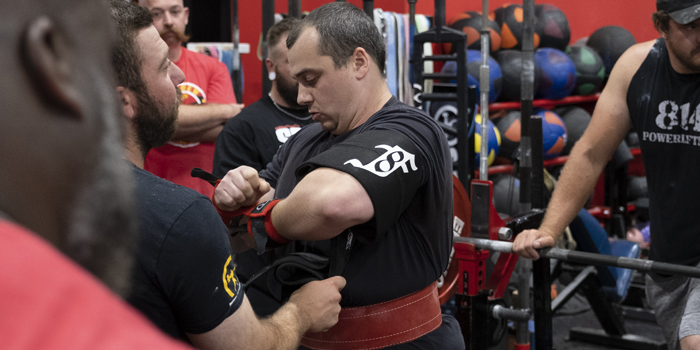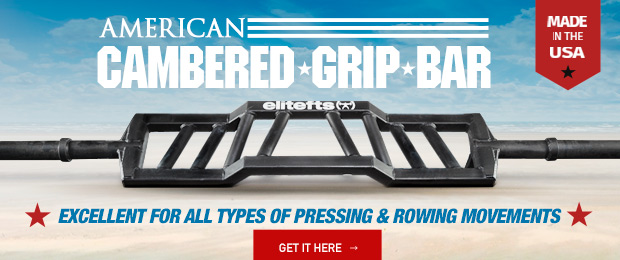
I can hear you now, "Oh great, another bench press article."
I get it.
The bench press is always at the top of the list regarding training information. But the bench press has a special place in my heart.
I knew, from the first time I got on a bench at 13 years old, I wanted to be a lifter. And in the nearly twenty years since, I have obsessed over benching big weights. Of course, I have made my share of mistakes, but I have also picked up a few things along the way.
So, if you are like me and love to bench press, this article is for you. And even with the abundance of information available, we all still have room for improvement. Here are six tips to become a beast on the bench.
Tip #1: Use Your Lower Body
A big bench press starts with your feet. Yes, you read that right.
For foot placement, we first need to talk about heel up or down. In some federations, keeping the heel on the ground is required. However, a flat foot may be optimal from a stability standpoint. With the feet flat, we have more connection to the floor, allowing us to drive through the front of our shoe better.
Feet placement will be individual based on limb lengths, height, weight, etc. You can go with your feet tucked underneath, straight down, or put them out in front.
For generating leg tension, straight down or out in front is best for most people. You can also go with a narrow stance with your legs close to the bench or a little wider, almost in a squat stance. Either way can work. You may have to play around and see what allows you to create the most tension.
Before moving on, the concept of leg drive needs to be clarified.
The thing is, it is not even about leg drive per se. The legs are not driving the bar up. Leg drive is about stability and tension. You do not want any leaks in the chain.
The crucial point about “leg drive” is it is a horizontal force, not a vertical one. Think of a leg extension, not a leg press.
The foot pressure should drive your toes into the front of your shoes. Use it to slide you up the bench. You want to be borderline driving yourself right off the bench. This is where having a grippy bench pad to hold you in place is one of the significant benefits of using high-quality equipment. If you train at a commercial gym, put a band on the bench to create traction.
Tip #2: Set Up Correctly
The setup is vital for all three lifts but will make or break the bench press.
Once your hands are set, use your feet to drive you into position. The goal is to dig your traps into the bench and get the upper back tight. You want to get set as high on your traps as possible.
You want to use our legs to keep the tension on the traps. Tension on the traps is the key to creating and maintaining the arch. It is a leg drive that allows you to elevate the rib cage and sternum to fold yourself into the arch position. It is almost impossible to create an arch just by the back alone. The arch is important because it shortens the range of motion but also puts you in a better position to press.
If you struggle with this, elevating your hips and performing what looks like a glute bridge can help you get the right angle to drop your traps onto the bench. That is why many people bring their feet onto the bench during the setup process. You can do the same thing, keeping your feet on the floor by raising your hips.
Let me know if this sounds familiar. You get set up, your traps are on the bench, and everything is going great. Until you unrack the bar and actually perform the lift. Somewhere between getting set up and unracking the bar, everything went downhill. Nine times out of ten, this is from losing lower body tension. Creating tension during the setup is not enough. You have to maintain it.
Once you get your feet set, create constant lower body tension and foot pressure for the duration of the set. When people say the bench is a full-body movement, that is what they mean.
Tip #3: Find the Right Assistance Movements
Assistance movements are very individual. What works best for me will not necessarily work best for you. The tip is not so much a prescription as it is permission to experiment.
Refrain from riding the wave of what is fashionable on social media. Assistance movements are like diets, floating in and out of popularity.
With that in mind, here are a few assistance movements I have succeeded with.
RECENT: 6 Underrated Exercises for Building Muscle and Strength
Close Grip Bench Press: I like the Close Grip Bench if you use a wide competition grip. Using a narrow grip for an assistance movement allows us to hit the triceps and extend the range of motion a bit.
Long Pause Bench Press: The Long Pause Bench Press is excellent for getting more comfortable and confident pausing the bar on the chest. A competition press command will seem like nothing if you regularly hold a three- or four-second pause. Plus, this takes away some of the stretch reflexes at the bottom.
Larsen Press: The Larsen Press is a feet-up bench press variation. With the Larsen variation, your legs hang straight off the bench while hovering above the floor. The lift forces you to maintain upper back tightness and generate force without the legs. Additionally, with the legs hanging off the bench, there is a high stability demand, making it hard to control the barbell. Set up for these the same way you would for a standard bench. Bring your feet up at the last second after unracking the bar.
Honorable mention: Dumbbell Bench Press, Machine Chest Press, and Weighted Dips. I like high-rep dumbbell benching because once you get strong enough, the big dumbbells are a pain in the ass. Pressing the 150-pound dumbbells looks cool on Instagram, but the fight to get them into position, and the five or six half reps you do, is not. I would rather just hit sets of 20 with the 100s.
Tip #4: Frequent Singles
A tip that made a significant difference in my bench is including weekly singles between 85–95 percent year-round.
Keep in mind, I am not saying maxing out every week. I am saying submaximal singles each week. 85–95 percent is about a six to nine RPE. Hanging around seven to eight RPE is the sweet spot for most people.
The trick is to avoid getting too connected to a specific number. For some people, programming the single based on RPE works well. However, others do better programming their singles based on percentages.
For the most part, I like to progress the singles in a step-loading fashion, meaning I am not trying to linearly increase them. Trying to improve the weekly single linearly, even at lighter loads, is a mistake.
To step load, you essentially just stick with the same weight until it is noticeably cleaner, faster, and/or easier. In the offseason, I may start someone off with a single at an eight RPE programmed out, and we will be consistent with that weight for a long time until it is a six to seven RPE. I like building consistency with one weight until you own that weight.
Tip #5: Hold the Bar at the Top and Pause Every Rep in Training
These two tips are primarily for competitors.
If you are a powerlifter, pause every rep in training. I have talked about this extensively on my podcast, but as a competitive powerlifter, I do not see a good argument for programming touch and go bench. Maybe for higher rep sets, but that is it. It is like squatting high in training.
However, as crucial as paused reps are, practicing holding the bar at the top is a game changer. I am surprised more people do not do this.
The goal is to get used to holding the bar at the top for a few seconds before starting your set. Not holding the bar at the top is the one thing that will crush your bench at a meet that you are probably not thinking about. I have seen it a hundred times.
Every single rep you do in training should start by holding the bar at the top for a few seconds to mimic waiting for the start command. Also, get in the habit of getting your elbows locked out as soon as possible when you unrack the bar to get a quicker start command.
Tip #6: Bench Press More Than Once Per Week
You have probably heard this before, but the bench responds very well to a higher-frequency approach. It is true, but it is more about volume than frequency. There is even some research to support this. A 2018 Meta-Analysis showed higher training frequencies produced more strength gains, but only when the volume was higher. When the volume was the same, frequency alone did not improve strength [1].
Out of the three lifts, the bench typically can handle the most work. The problem is, how many quality sets can you do in one workout? Three or four? Five is most likely the max. So, as soon as you need six sets per week, increasing bench frequency will allow you to get in more high-quality sets.
Most powerlifters bench two to four times per week. But do not jump to benching four times a week because your favorite IG lifter does. Reverse engineer it. Determine how many weekly sets you need to progress and divide them into multiple sessions. And if your bench is stalled, adding a couple of extra weekly sets might be what you need to get it moving again.
References
- Grgic J, Schoenfeld BJ, Davies TB, Lazinica B, Krieger JW, Pedisic Z. Effect of Resistance Training Frequency on Gains in Muscular Strength: A Systematic Review and Meta-Analysis. Sports Med. 2018 May;48(5):1207-1220. doi: 10.1007/s40279-018-0872-x. PMID: 29470825.
Kyle Hunt is an author, podcast host, trainer, powerlifter, and the founder of Hunt Fitness. Hunt Fitness is a popular online fitness coaching business that started in 2010. He lives in South Carolina with his wife, three children, and three cats.











